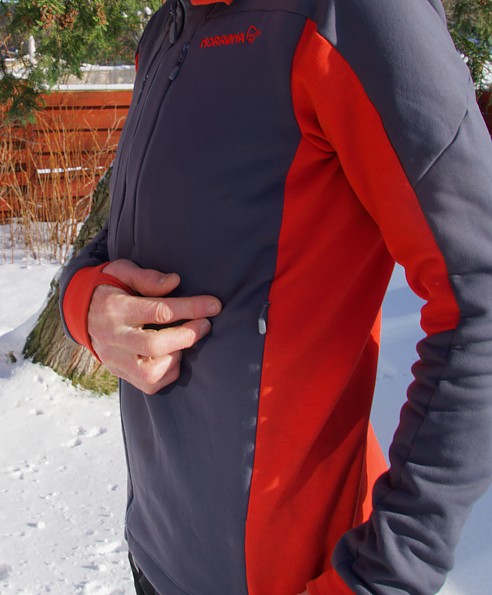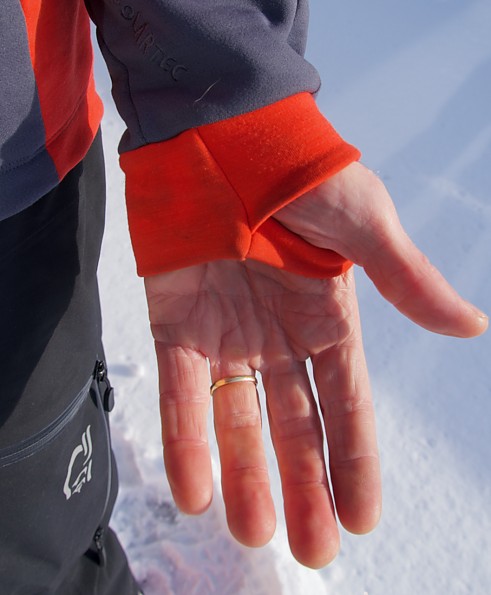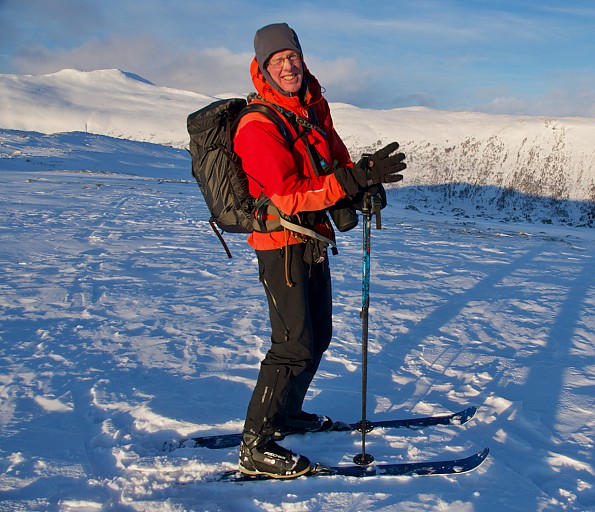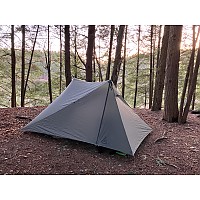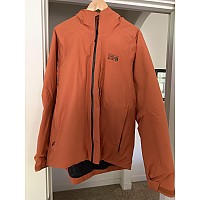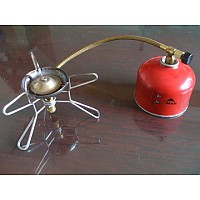Norrona Trollveggen Powerstretch Pro Zip Hoodie

The Trollveggen Powerstretch Pro Zip Hoodie is a warm, functional, and stylish Polartec Power Stretch Pro fleece hoodie for the mountain life, that also works as high fashion in Norwegian circles. Stretch fit goes on well over a base layer and under both close and loose fitting shell layers. A great mid layer for cold weather ascents, with a hood to help keep moving without having to layer up when the wind comes up.
Pros
- Stretch fit layers well
- Zips up to chin
- Hood up for a quick warm up on summit changeovers
- Roomy zip chest pockets accommodate mid-size mobile phone
- Hand warmer pockets positioned above harness or hip belt
- Thumb holes in cuffs
Cons
- Fleece sheds plastic microfibers into the environment
The word norrøn (norr-RUHN, roll those Rs a little) is best translated as “Norse,” a general name for Scandinavian people of the Viking age, including settlers and traders rather than just the Viking raiders. Norrøna the brand, with its helmeted Viking logo, is the Patagonia of Norway: colorful, uncompromising, and pricey outdoor clothing that is as likely to be seen on the streets of Oslo or Trondheim as on a Norwegian summit.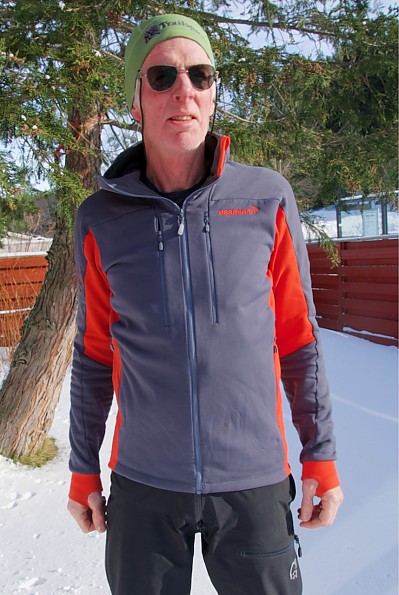
The Trollveggen Powerstretch Pro Hoodie is a simple mid-layer stretch fleece jacket for all-round mountain action. Its close, stretch fit gives warmth and comfort in a functional and stylish package. 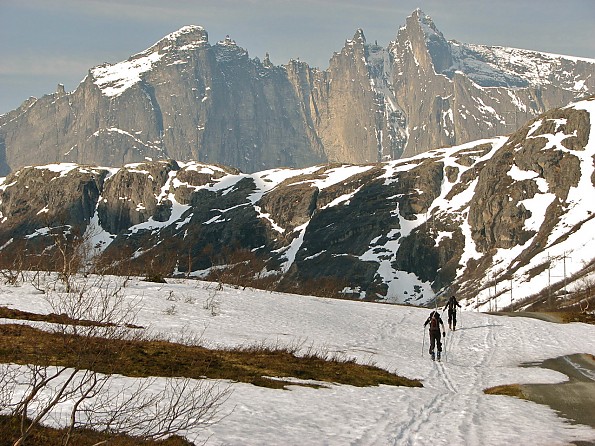
Norrøna’s Trollveggen lineup is named after the storied Troll Wall in Romsdalen, one of the great big walls of the world and includes other base-to-shell layer garments, and is Norrøna's "workwear for the mountain," offering durability and high performance in all kinds of mountain weather.
Materials, Construction, and Weight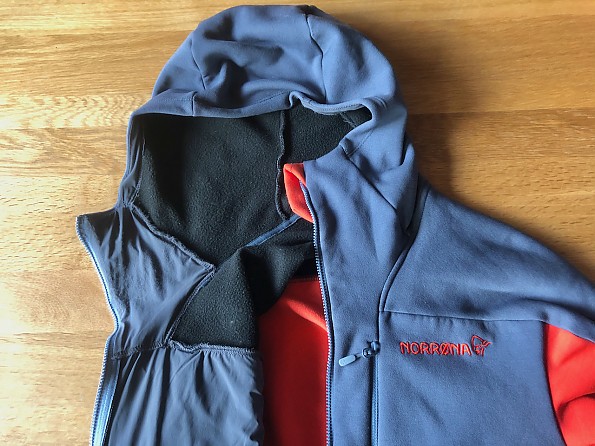
The front, shoulders, outer arms, and hood are made of four-way stretch Polartec Power Stretch Pro—the gray fabric in my jacket. It is woven from 57 percent recycled polyester, with 10 percent elastane for stretch and the remaining 33 percent nylon for toughness and abrasion resistance. The back panel and underarms, orange in my jacket, are made of a different blend: 76 percent recycled polyester, 6 percent elastane, and 18 percent wool for extra warmth, breathability, and stink resistance. Both materials are pleasantly stretchy, giving a close fit but allowing plenty of freedom of movement, with a smooth outer finish and a brushed inner surface.
I have the “cool black” color variant, actually a neutral gray with orange back and arm accents. It is currently also available in all black and royal blue/grey versions. A thin, lightweight, stretch fabric serves as a pocket liner on the front inside of the jacket, and reinforces the hem and edge of the hood.
Norrøna notes that the fabric is more than 50 percent recycled and cites a couple of other sustainability and testing certifications.
The two generous chest pockets can swallow big mobile phones or a sunglass case, and the two handwarmer pockets are positioned high enough to avoid competition with a climbing harness or pack waist belt. All four pockets close with small gauge coil sippers, while the main zipper is a more robust #3 toothed zipper. The handwarmer pocket zippers disappear into the seams between the front and back panels.
The jacket is cut a long in the back to keep the waist covered during movement. 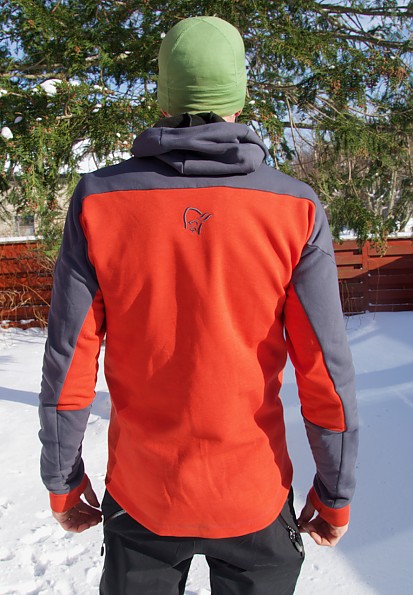
Thumb holes in the cuffs hold the sleeves down when layering up and can be used to boost hand warmth a bit.
My size Large weighs 538 grams, about 40 grams more than my hooded down sweater and a little less than my 20-year-old, loose-fitting, hoodless Patagonia R2 Jacket.
Fit, Comfort, and Layering
Norrøna describes its sizes as "technical" and offers four sizes (S-XL) for both men and women. As a tall, skinny guy, getting a good fit is often an issue for me, as most outdoor clothing comes in the four canonical sizes and long sizes are rare. For base and mid layers, XL is usually way too loose, while L is often a bit short in the sleeves and body. In this case, a size L gives a good fit, with the sleeves long enough for me to use the thumb holes without feeling stretched, but in my case maybe a little looser than intended around the belly.
The multipanel design and stretch fabric should accommodate considerable variation in body form. If it fit much closer than it does it might start to feel a little confining, but the stretch fabric follows arm and body movements well.
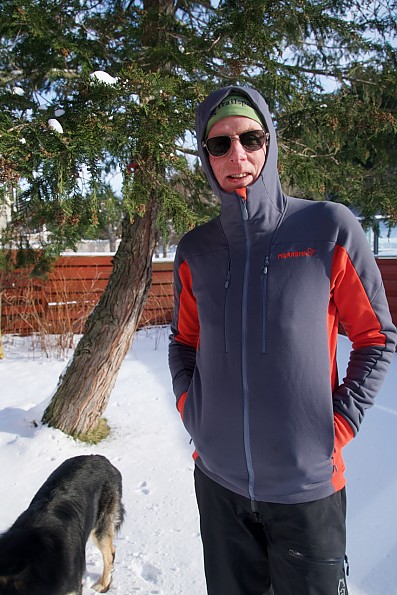 The hood does not have drawstrings for snugging on the head or around the face, instead relying on stretch fit to stay in place and move with the head. It goes on easy over a beanie, but, contrary to Norrøna's description, I could only get my ski helmet on comfortably over the hood (no beanie) by taking the helmet liner out. The collar zips up over the chin to help seal out drafts when the wind blows.
The hood does not have drawstrings for snugging on the head or around the face, instead relying on stretch fit to stay in place and move with the head. It goes on easy over a beanie, but, contrary to Norrøna's description, I could only get my ski helmet on comfortably over the hood (no beanie) by taking the helmet liner out. The collar zips up over the chin to help seal out drafts when the wind blows.
The brushed fleece inside feels great on bare skin, a luxury I sometimes indulge in when lounging around a hut aprés ski.
Layering up for going outdoors can often be an exercise in microadjustment, tugging down and untwisting sleeves and body until everything is in the right place. The stretch fleece eases that process by going on smoothly over a base layer but staying in place as the shell layer goes on.
Warmth, Breathability, and Drying
The close fit of the Trollveggen maximizes its insulating value and it warms up quickly. It’s not quite as warm as a down sweater, but doesn’t compress and feels a little warmer than my down sweater on the shoulders. I have worn it in reasonable comfort under a shell for short lunch breaks in windy, below freezing conditions, but for longer breaks I would want to break out another layer—I often throw on a roomy hooded puffy over my shell.
Worn under a shell on cold-weather ski ascents, the jacket breathes and wicks well enough to stay dry, even as the base layer may be getting a little soggy from sweat.
I have not given the Norrøna hoodie a full drying test, but in general fleece is warm when wet, dries fast for its weight and warmth, and the close-to-body fit should aid in on-body drying. I think its range of use will extend well into the summer months, especially here in Norway when it's warm-when-wet and fast drying characteristics are a plus in our cool and often wet weather.
Abrasion Resistance
According to Polartec, the surface stretch fibers are reinforced with nylon for abrasion resistance and durability under repeated stretching. Norrøna has kept it simple by not adding any reinforcement on the elbows, a key wear area. Otherwise the jacket should hold up well over the years. After a few months of regular use, there is some pilling of the liner fabric around the chin.
Conditions and Best Use
I have been using this jacket as my main mid layer, replacing a hooded down sweater, on all my backcountry ski tours this winter, often as my only mid layer on descents. It has also been seeing a lot of use on my short, daily bicycle commute to work. It certainly serves well as a mid-layer for backcountry skiing.
In general it should perform well in cold/wet conditions under moderate to intense activity, including in mountain summer weather. This hoodie would have been nice to have when I was struggling to keep warm in all-day wind and rain on a recent five-day hike on the Hornstrandir Peninsula in Iceland.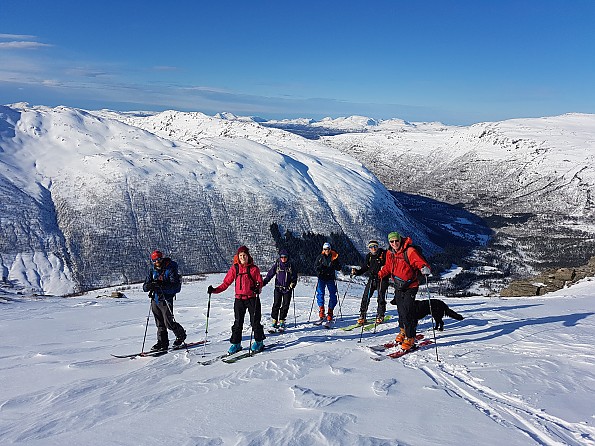
Background
As a lifelong skier and winter, fleece "fuzzies" have been part of my layering system since they first appeared in the early '80s (as best I can recall).
Source: received for testing via the Trailspace Review Corps
(Sample for testing and review provided by Norrona)
Your Review
Where to Buy
You May Like
Specs
| Men's | |
|---|---|
| Price |
MSRP: $189.00 Current Retail: $279.00 Historic Range: $112.05-$279.00 |
| Weight |
524 g |
| Fabric |
Polartec Power Stretch Pro |
|
More than 50% of the synthetic fibers in this product are recycled. |
|
|
Bluesign approved fabric / Oeko-Tex certified fabric |
|
| Women's | |
|---|---|
| Price |
MSRP: $189.00 Historic Range: $105.33-$269.00 |
| Weight |
412 g |
| Fabric |
Polartec Power Stretch Pro |
|
More than 50% of the synthetic fibers in this product are recycled. |
|
|
Bluesign approved fabric / Oeko-Tex certified fabric |
|


























 Reviewed by
Reviewed by
